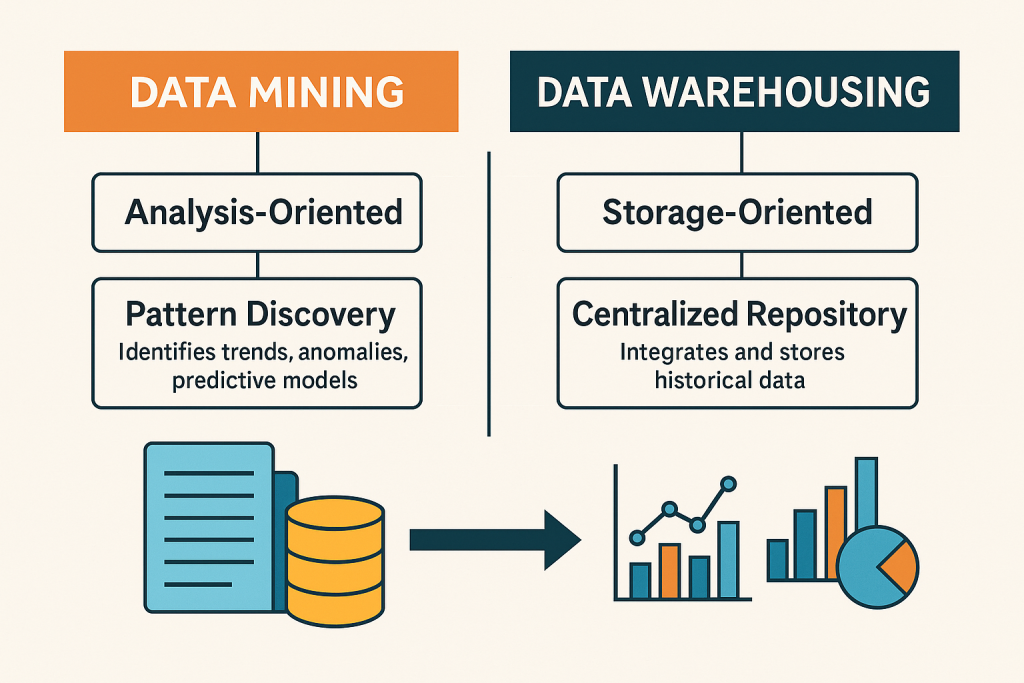In the ever-evolving world of data science and analytics, two terms often emerge in conversations: Data Mining and Data Warehousing. Though they sound similar and are closely related in the data processing pipeline, they serve entirely different purposes. Understanding the differences between them is essential for businesses and professionals looking to leverage data for insights and decision-making.
In this blog post, we’ll break down what data mining and data warehousing are, how they differ, and where each fits into the broader data ecosystem.
What is Data Warehousing?
Data Warehousing is the process of collecting, storing, and managing large volumes of data from various sources in a central repository. A Data Warehouse is designed to support querying and reporting, providing a consolidated view of historical data across an organization.
Key Characteristics of Data Warehousing:
- Storage-Oriented: It focuses on storing vast amounts of data efficiently.
- Centralized Repository: Integrates data from multiple sources (e.g., databases, CRMs, ERPs).
- Historical Data: Stores historical data for trend analysis.
- Supports Business Intelligence: Enables tools like dashboards and reports.
- Optimized for Read Operations: Not ideal for transaction processing.
Example Use Case:
A retail company uses a data warehouse to store sales data from all its outlets, enabling management to analyze trends over time and make inventory decisions.
What is Data Mining?
Data Mining is the process of discovering patterns, correlations, and insights from large datasets using statistical, machine learning, and AI techniques. It goes beyond just querying data—it aims to uncover hidden patterns that are not immediately obvious.
Key Characteristics of Data Mining:
- Analysis-Oriented: Focuses on discovering relationships and patterns in data.
- Pattern Discovery: Identifies trends, anomalies, and predictive models.
- Uses Algorithms and Models: Employs classification, clustering, regression, and association rule learning.
- Requires Clean Data: Typically performed on data that has already been processed and stored (often in a data warehouse).
- Supports Decision-Making: Helps in making predictions and strategic decisions.
Example Use Case:
An e-commerce platform uses data mining to analyze user purchase history and predict which products a user is likely to buy next, enabling personalized recommendations.
Key Differences at a Glance
| Feature | Data Warehousing | Data Mining |
|---|---|---|
| Purpose | Storage and retrieval of historical data | Extraction of insights and patterns |
| Focus | Data consolidation and management | Data analysis and pattern recognition |
| Tools/Techniques | ETL (Extract, Transform, Load), SQL | Machine learning, statistics, AI |
| Type of Data | Structured, cleaned, historical data | Structured or semi-structured data |
| End Users | Business analysts, data engineers | Data scientists, analysts, researchers |
| Typical Output | Reports, dashboards | Models, predictions, insights |
How They Work Together
Think of data warehousing as the foundation, and data mining as the exploration. Before you can mine data effectively, you need a structured and clean source of data—which is what a data warehouse provides. Together, they enable data-driven organizations to transition from simply storing data to extracting actionable intelligence.
Conclusion
While data mining and data warehousing are distinct in their functions, they are complementary processes. A robust data warehouse lays the groundwork for effective data mining, and data mining adds value by uncovering insights that inform strategic decisions. Whether you’re building a data pipeline or exploring new business opportunities, understanding these two concepts is essential in today’s data-centric world.


